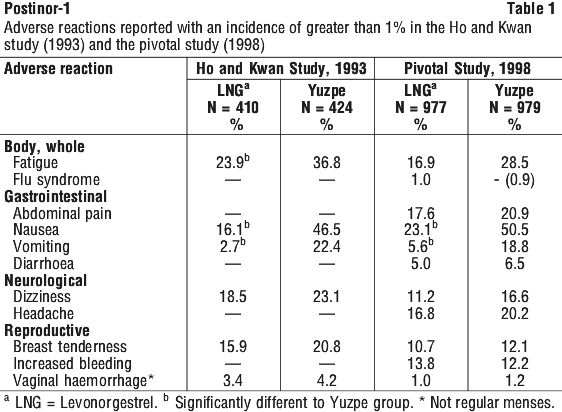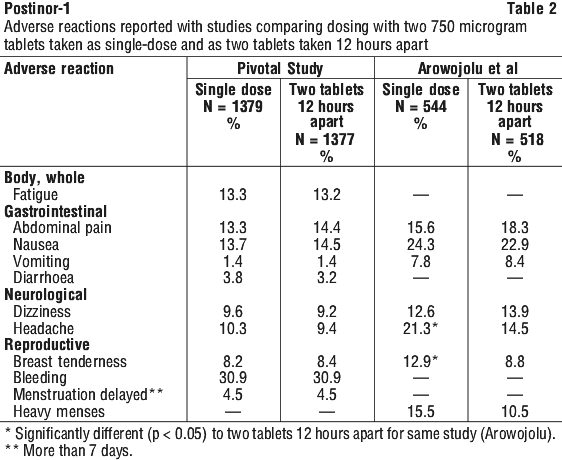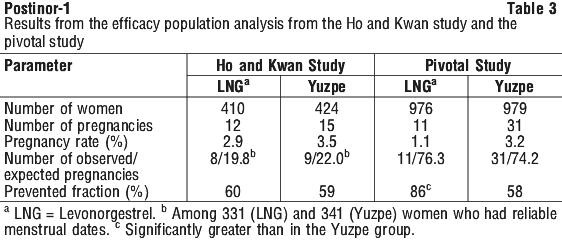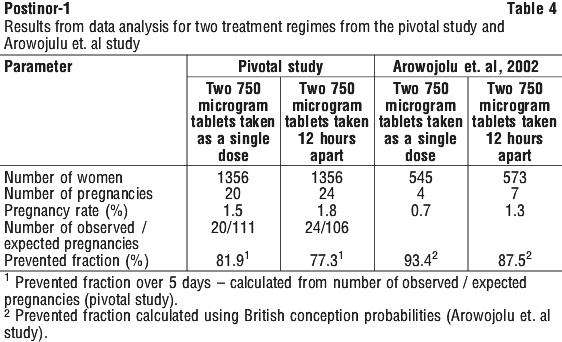SUMMARY CMI
POSTINOR-1
Consumer Medicine Information (CMI) summary
The full CMI on the next page has more details. If you are worried about using this medicine, speak to your doctor or pharmacist.
1. Why am I taking Postinor-1?
Postinor-1 contains the active ingredient levonorgestrel. Postinor-1 is used as an emergency contraceptive.
For more information, see Section 1. Why am I taking Postinor-1? in the full CMI.
2. What should I know before I take Postinor-1?
Do not use if you have ever had an allergic reaction to Postinor-1 or any of the ingredients listed at the end of the CMI.
Talk to your doctor if you have any other medical conditions, take any other medicines, or are pregnant or plan to become pregnant or are breastfeeding.
For more information, see Section 2. What should I know before I take Postinor-1? in the full CMI
3. What if I am taking other medicines?
Some medicines may interfere with Postinor-1 and affect how it works.
A list of these medicines is in Section 3. What if I am taking other medicines? in the full CMI.
4. How do I take Postinor-1?
- Take one tablet as soon as possible, preferably within 12 hours and no later than 72 hours (3 days) after you have had unprotected sex.
- Swallow the tablet whole, with water. Do not chew.
More instructions can be found in Section 4. How do I take Postinor-1? in the full CMI.
5. What should I know while taking Postinor-1?
| Things you should do |
|
| Things you should not do |
|
| Driving or using machines | Do not drive or use machines if you feel dizzy after using Postinor-1. |
| Drinking alcohol | Tell your doctor or pharmacist if you drink alcohol. |
| Looking after your medicine | Store the medicine in a cool, dry place where the temperature is below 25°C. |
For more information, see Section 5. What should I know while taking Postinor-1? in the full CMI.
6. Are there any side effects?
The most common side effects are tiredness, nausea and vomiting. Other side effects are stomach pain, diarrhoea, dizziness, headache, tender breasts, increased vaginal bleeding, and skin reactions.
For more information, including what to do if you have any side effects, see Section 6. Are there any side effects? in the full CMI.
FULL CMI
POSTINOR-1
Active ingredient(s): levonorgestrel
Consumer Medicine Information (CMI)
This leaflet provides important information about using Postinor-1.
You should also speak to your doctor or pharmacist if you would like further information or if you have any concerns or questions about taking Postinor-1.
Where to find information in this leaflet:
1. Why am I taking Postinor-1?
2. What should I know before I take Postinor-1?
3. What if I am taking other medicines?
4. How do I take Postinor-1?
5. What should I know while taking Postinor-1?
6. Are there any side effects?
7. Product details
1. Why am I taking Postinor-1?
Postinor-1 contains the active ingredient, levonorgestrel. Postinor-1 is an emergency contraceptive only. Postinor-1 is not intended as a regular method of contraception.
It is used to prevent pregnancy when taken within 72 hours (3 days) of unprotected intercourse (sex).
It is estimated that Postinor-1 will prevent 85% of expected pregnancies when you take it within 72 hours of having unprotected sex. It will not prevent a pregnancy every time and is more effective if you take it as soon as possible after unprotected sex.
Postinor-1 is most effective if taken within 72 hours of unprotected sex. But remember that the sooner you take it, the more likely it will prevent pregnancy.
Postinor-1 will not prevent you from catching sexually transmitted diseases. Ask your doctor or pharmacist if you have any questions about why you are taking Postinor-1.
Postinor-1 is thought to work by:
- stopping your ovaries from releasing an egg;
- preventing sperm from fertilising any egg you may have already released.
Postinor-1 can only prevent you becoming pregnant if you take it within 72 hours of unprotected sex. It does not work if you are already pregnant. If another unprotected intercourse takes place after the use of Postinor-1 (also if this is during the same menstrual cycle), the tablet will not work and there is again the risk of pregnancy.
2. What should I know before I take Postinor-1?
Warnings
Do not take Postinor-1 if you:
- are allergic to levonorgestrel or any of the ingredients listed at the end of this leaflet. Always check the ingredients to make sure you can use this medicine.
- are pregnant.
- have have previously had unprotected intercourse more than 72 hours earlier in the same menstrual cycle, as you may already be pregnant
- are experiencing vaginal bleeding for which the reason is not known.
- have breast cancer.
- notice that the tablets do not look quite right.
Do not take Postinor-1 after the expiry date printed on the pack or if the packaging is torn or shows signs of tampering.
Before you start treatment with Postinor-1, your doctor or pharmacist should:
- check you are not already pregnant if he/she suspects you may already have been pregnant before this occurrence of unprotected intercourse.
- ask if you are taking any other medicines (see 3. What if I am taking other medicines?).
- ask if you suffer from high blood pressure.
- advise you of the need for careful use of a barrier method of contraception until you have your next period.
- advise you to see your doctor in three weeks' time, especially if you have not had a period by then.
- discuss the need for regular contraception.
You should consult with your doctor before you take Postinor-1 if you:
- have diabetes mellitus (with kidney, eye or nerve damage, or vascular disease). Diabetes mellitus is a condition in which the body does not produce enough insulin or else the body tissues are not able to use the insulin present. This leads to hyperglycaemia (too much sugar in the blood).
- have ischaemic heart disease (heart disease caused by reduced blood flow in the blood vessels of the heart muscle).
- have suffered a stroke.
- have had breast cancer.
- are pregnant or think that you may already be pregnant. This medicine will not work if you are already pregnant. If you are already pregnant, Postinor-1 cannot terminate pregnancy. Postinor-1 is not an “abortion pill”. You may already be pregnant if:
- your period is more than 5 days late, or you have experienced unusual bleeding when your next period is due
- you have had unprotected sex more than 72 hours ago and since your last period
If any of these conditions apply to you, it may not be suitable for you to take Postinor-1.
The use of Postinor-1 is not advised if you:
- have a disease of your gastrointestinal tract (such as Crohn's disease) that interferes with the digestion and absorption of your food.
- have severe liver disease.
- have a history of ectopic pregnancy (where the baby develops somewhere outside the womb).
- have a history of salpingitis (inflammation of the fallopian tubes).
A previous ectopic pregnancy or previous infection of the fallopian tubes increases the risk of a new ectopic pregnancy. - are vomiting or have severe diarrhoea.
Emergency contraception should be taken as soon as possible after unprotected intercourse.
You should only use Postinor-1 in emergencies and not as a regular method of contraception. If Postinor-1 is used more than once in a menstrual cycle, it is less reliable and it is more likely to upset your menstrual cycle (period).
Postinor-1 does not work as well as regular methods of contraception. Your doctor, practice nurse or family planning clinic can tell you about long-term methods of contraception which are more effective in preventing you from getting pregnant.
Pregnancy and breastfeeding
Check with your doctor or pharmacist if you are pregnant or intend to become pregnant.
You should not take this medicine if you are already pregnant. If you do become pregnant even after taking this medicine, it is important that you see your doctor. Your doctor may want to check that the pregnancy is not ectopic (where the baby develops somewhere outside the womb). This is especially important if you develop severe abdominal pain after taking Postinor-1, or if you have previously had an ectopic pregnancy, fallopian tube surgery, or pelvic inflammatory disease.
Talk to your doctor or pharmacist if you are breastfeeding or intend to breastfeed. The active ingredient of this medicine is excreted into your breast milk. Therefore, it is suggested that you take your tablet immediately after breastfeeding and avoid nursing at least 3 days after taking this medicine.
Fertility
Postinor-1 increases the possibility of menstruation disturbances which can sometimes lead to an earlier or later ovulation date resulting in a modified fertility date. Although there are no fertility data in the long term, after treatment with Postinor-1 a rapid return to fertility is expected and therefore, regular contraception should be continued or initiated as soon as possible after Postinor-1 use.
Children and adolescents
Postinor-1 is not recommended for children. There is only limited information available on Postinor-1 when taken by women aged 14-16 years and no information on its use in younger women or children.
3. What if I am taking other medicines?
Tell your doctor or pharmacist if you are taking any other medicines, including any medicines, vitamins or supplements that you buy without a prescription from your pharmacy, supermarket or health food shop.
Some medicines may interfere with Postinor-1 and affect how it works.
Examples of medicines which may interfere with Postinor-1 are:
- medicines used to treat epilepsy (e.g. barbiturates, primidone, phenytoin, and carbamazepine).
- medicines used to treat tuberculosis (e.g. rifampicin, rifabutin).
- medicines used to treat HIV infection (ritonavir, efavirenz).
- medicines used to treat fungal infections (griseofulvin).
- herbal medicines containing St John's Wort (Hypericum perforatum).
Postinor-1 may affect the way other medicines work:
- a medicine called cyclosporine (suppresses the immune system).
Check with your doctor or pharmacist if you are not sure about what medicines, vitamins or supplements you are taking and if these affect Postinor-1.
4. How do I take Postinor-1?
How much to take
The dose is one tablet.
If you vomit within 2 hours of taking the tablet you should return to your pharmacy, doctor or clinic as the tablet may not be absorbed and you will need to take an additional tablet.
When to take Postinor-1
Take the tablet as soon as possible, preferably within 12 hours, and no later than 72 hours (3 days) after you have had unprotected sex.
Do not delay taking the tablet. The tablet works best the sooner you take it after having unprotected sex. It can only prevent you becoming pregnant, if you take it within 72 hours of unprotected sex.
- Postinor-1 can be taken at any time in your menstrual cycle, assuming you are not already pregnant or think you may be pregnant.
- If you are using one of the medicines that may prevent Postinor-1 from working properly (see section 3. What if I am taking other medicines?) or if you have used one of these medicines in the past 4 weeks, Postinor-1 may not work as well for you.
- If you are already using a regular method of contraception, such as the contraceptive pill, you can continue to take this at your regular times.
If another unprotected intercourse takes place after the use of Postinor-1 (also if this is during the same menstrual cycle), the tablet will not be effective and there is again the risk of pregnancy.
Speak to a healthcare professional if you are concerned about any problems related to taking emergency contraception.
How to take Postinor-1
Swallow the tablet whole, with water. Do not chew.
After taking Postinor-1
You should see your doctor within 3 weeks of taking Postinor-1 to make sure that Postinor-1 has worked.
You may experience spotting or vaginal bleeding earlier than expected.
If you do not get your period, it is more than 5 days late or is unusually light or unusually heavy, you must see your doctor, as you may be pregnant. If Postinor-1 does not work, you could be pregnant. Your doctor will order a pregnancy test. If stomach pain is severe you should see your doctor immediately as on rare occasions a tubal pregnancy could occur.
Postinor-1 is only intended as an emergency measure. If you have not already done so you should discuss with your doctor other methods of long term contraception.
You should not breast feed within 3 days after taking Postinor-1.
If you use too much Postinor-1
If you think that you have taken too many Postinor-1 tablets, or if a child has taken Postinor-1 tablets, you should immediately:
- phone the Poisons Information Centre
(by calling 13 11 26), or - contact your doctor, or
- go to the Emergency Department at your nearest hospital.
You should do this even if there are no signs of discomfort or poisoning.
Although there have been no reports of serious harmful effects from taking too many tablets at once, you may feel sick, actually be sick (vomit), or have vaginal bleeding. You should ask your pharmacist, doctor, practice nurse or family planning clinic for advice, especially if you have been sick, as the tablet may not have worked properly.
5. What should I know while taking Postinor-1?
Things you should do
Remind any doctor, dentist or pharmacist you visit that you have taken Postinor-1.
Postinor-1 contains lactose.
Each Postinor-1 tablet contains 142.5 mg lactose monohydrate.
If you have been told by your doctor that you have an intolerance to some sugars, contact your doctor before taking this product.
Things you should not do
Do not give Postinor-1 to anyone else.
Where to go for further information
If you require further information, you should contact your pharmacist, doctor or clinic.
Additional information is also available at the website: www.emergencycontraception.com.au
Driving or using machines
Be careful before you drive or use any machines or tools until you know how Postinor-1 affects you.
If Postinor-1 makes you drowsy or dizzy, do not drive a car or operate machinery.
Drinking alcohol
Tell your doctor or pharmacist if you drink alcohol
Looking after your medicine
Keep your tablet in the pack until it is time to take it. If you take the tablet out of the pack, it will not keep well.
Keep your tablet in a cool, dry place where the temperature stays below 25°C.
Do not store Postinor-1 or any other medicine in the bathroom or near a sink.
Do not leave it in the car on hot days or on window sills.
Heat and dampness can destroy some medicines.
Keep it where young children cannot reach it.
A locked cupboard at least 1½ metres above the ground is a good place to store medicines.
When to discard your medicine
The expiry date is printed on the pack and the foil blister.
Do not use Postinor-1 after this expiry date.
Getting rid of any unwanted medicine
If you no longer need to use this medicine, or it is out of date, take it to any pharmacy for safe disposal.
Do not use this medicine after the expiry date.
6. Are there any side effects?
All medicines can have side effects. If you do experience any side effects, most of them are minor and temporary. However, some side effects may need medical attention.
See the information below and, if you need to, ask your doctor or pharmacist if you have any further questions about side effects.
Less serious side effects
| Less serious side effects | What to do |
Gastrointestinal
| Speak to your doctor if you have any of these less serious side effects and they worry you. |
Serious side effects
| Serious side effects | What to do |
Gastrointestinal
| Call your doctor straight away, or go straight to the Emergency Department at your nearest hospital if you notice any of these serious side effects. |
Tell your doctor or pharmacist if you notice anything else that may be making you feel unwell.
Other side effects not listed here may occur in some people.
Reporting side effects
After you have received medical advice for any side effects you experience, you can report side effects to the Therapeutic Goods Administration online at www.tga.gov.au/reporting-problems. By reporting side effects, you can help provide more information on the safety of this medicine.
7. Product details
This medicine is available over-the-counter, without a doctor's prescription.
What Postinor-1 contains
| Active ingredient (main ingredient) | Levonorgestrel |
| Other ingredients (inactive ingredients) | Colloidal anhydrous silica Lactose monohydate Magnesium stearate Maize starch Potato starch Purified talc |
| Potential allergens | Lactose monohydrate |
Do not take this medicine if you are allergic to any of these ingredients.
What Postinor-1 looks like
Postinor-1 is a flat, white tablet.
It is supplied in a blister pack, containing one tablet.
The Australian registration number is AUST R 149269.
Who distributes Postinor-1
The distributor for Postinor-1 in Australia is:
Pharmacor Pty Ltd
Suite 803, Level 8,
Tower A, The Zenith,
821 Pacific Highway,
Chatswood NSW 2067
AUSTRALIA
Ph: 1300 138 805
www.pharmacor.com.au
This leaflet was prepared in November 2023.
Published by MIMS March 2024


 Side effects did not result in any discontinuations in either study. No ectopic pregnancies or congenital abnormalities were reported in either study. However, such a possibility must always be considered, as there have been rare reports of ectopic pregnancies reported during postmarketing surveillance. Cutaneous reactions have also been reported from postmarketing surveillance on rare occasions.
Side effects did not result in any discontinuations in either study. No ectopic pregnancies or congenital abnormalities were reported in either study. However, such a possibility must always be considered, as there have been rare reports of ectopic pregnancies reported during postmarketing surveillance. Cutaneous reactions have also been reported from postmarketing surveillance on rare occasions. One ectopic pregnancy was observed in the pivotal study and none in the supporting (Arowojolu) study.
One ectopic pregnancy was observed in the pivotal study and none in the supporting (Arowojolu) study. The relative risk of pregnancy in the Pivotal study for the Yuzpe versus levonorgestrel regimens was 2.8 with a lower one-sided 95% confidence bound of 1.53.
The relative risk of pregnancy in the Pivotal study for the Yuzpe versus levonorgestrel regimens was 2.8 with a lower one-sided 95% confidence bound of 1.53. There was no significant difference in efficacy between the two levonorgestrel treatment groups in the pivotal study. Shorter intervals between intercourse and treatment were associated with lower pregnancy rates in both groups.
There was no significant difference in efficacy between the two levonorgestrel treatment groups in the pivotal study. Shorter intervals between intercourse and treatment were associated with lower pregnancy rates in both groups. C21H28O2. Molecular weight: 312.45.
C21H28O2. Molecular weight: 312.45.